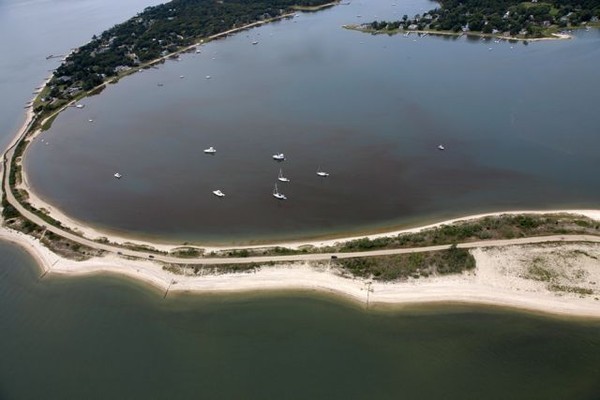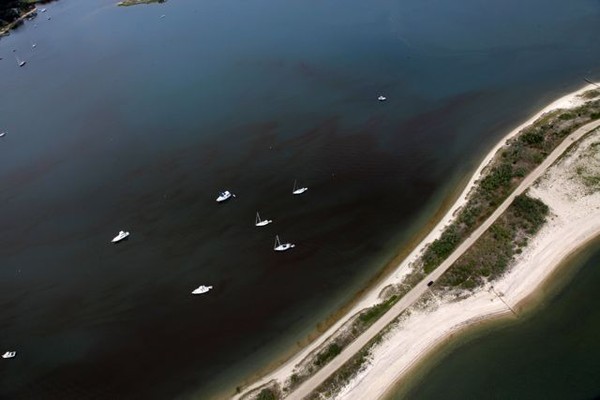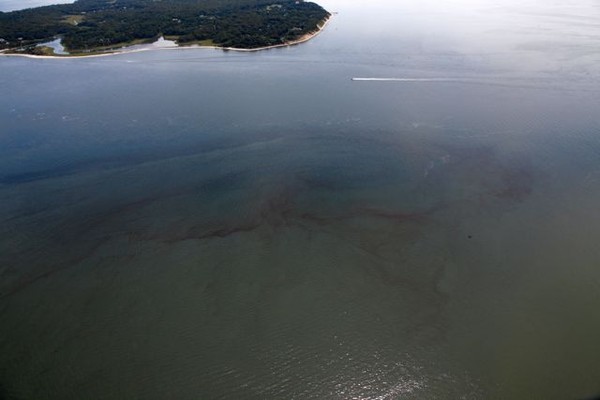Stony Brook, NY, August 27, 2012 - In July 2012, News 12 Long Island ran a special reports entitled "Brown Tide: Blight on the Bays" (
see related article, with transcripts and video clips).
One of the featured interviews in the report was with Dr. Chris Gobler, a Stony Brook University (SBU) researcher and professor at its School of Marine and Atmospheric Sciences (SOMAS). Dr. Gobler's research has been frequently funded by New York Sea Grant (NYSG).
This year marked the sixth consecutive year that the single-celled alga
Aureococcus anophagefferens - whose prolific blooms are known as “brown tide" - turned the waters brown from Long Island's western Shinnecock Bay to eastern Moriches Bay, making for intense, though localized, brown tide conditions.
"Right now, we're getting brown tide most commonly on the south shore of Long Island, between Great South Bay and Shinnecock Bay," said Gobler.
So, what's causing brown tide to stick around so long? "It's a combination of factors," says Gobler. "But we do know that we're finding it most commonly and most intensely in areas with high levels of organic nitrogen, areas that are very turbid with low light, and places with poor flushing rates - where the water isn't moving that much." In short, these kinds of algae blooms thrive on nitrogen, which finds its way into Long Island's waters from the effects of civilization on the shore.
One school of thought was that the nitrogen primarily came from fertilizers and animal waste washed into Long Island's bays by storm water runoff. But, as Gobler pointed out in the News 12 report, recent studies have shown most of it originates from a source closer to home: Cesspools and septic tanks.
"The math [via nutrient budgets] that's been done — quantifying the precise amount of nitrogen in pounds per day from different sources including the atmosphere, fertilizers, septic tanks, cesspools, sewage treatment plants — clearly shows that the large majority is from cesspools and septic tanks, going from land into these south shore estuaries," said Gobler.
"Other studies we've done have looked at the isotopic signature of nitrogen," he continued, "from which we've been able to identify that particular harmful algae - brown tide, but specifically red tide - is enriched with nitrogen that's coming from waste water.
Now, while there may be a lot of numbers to crunch to show that this is happening, the process by which this occurs is rather simple: Rain falls and sinks into the aquifer. Groundwater in the aquifer flows downhill, just like surface water.
"The groundwater travels through the aquifer, it's going towards the bay, it encounters all the cesspools and septic tanks and takes the nitrogen with it, and delivers it out into the bay," said Gobler.
It's a very slow process, though. Tainted groundwater flows only a couple of feet a day. So, ironically, the bays may just now be getting hit with the effects of explosive development in the 1960's and 70's.
As for red tide, Gobler recently told SouthamptonPatch.com that an algal bloom made its second earliest appearance (around August 2) since the species first started showing up in Long Island waters.
"It generally appears in late August," said Gobler. "As such, its arrival in late July this year is earlier than usual, perhaps due to the high water temperatures."

Red tide on the East End of Long Island, Aug. 7, 2012. Photo courtesy of SouthamptonPatch.com Credit: ©Cully/EEFAS
Gobler told the Southampton Patch reporter that the early arrival will likely lead to a more "intense and widespread" distribution of red tide, which he's found could impact fishermen, as the algae — though not toxic to humans — can be fatal to fish in dense atmospheres.
"The fishermen I've spoken to have said as soon as the bloom moves in, the fish move out," he said.
Red tide has appeared in Long Island waters every year since 2004, and Gobler said that the only year he has seen red tide earlier than this summer — his first confirmed report was the end of July — was in 2010.
As for the cause, he added that, "Prior research in my lab has demonstrated that these blooms are made worse by increased flow of nitrogen into these bays."
Nitrogen sources could include cesspools and fertilizers, though further research is still needed, Gobler added.
"Now we're working on specifically where that comes from."

Red tide on the East End of Long Island, Aug. 7, 2012. Photos courtesy of SouthamptonPatch.com Credit: ©Cully/EEFAS
